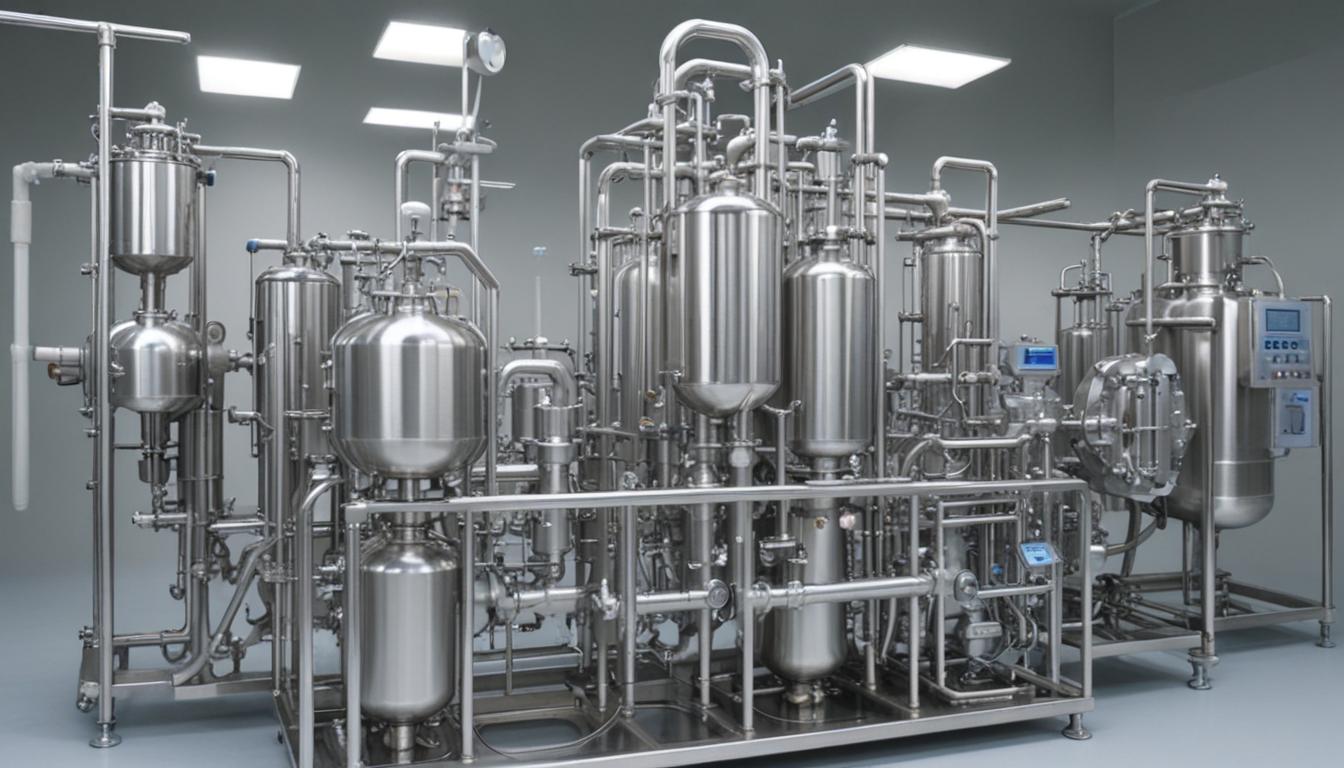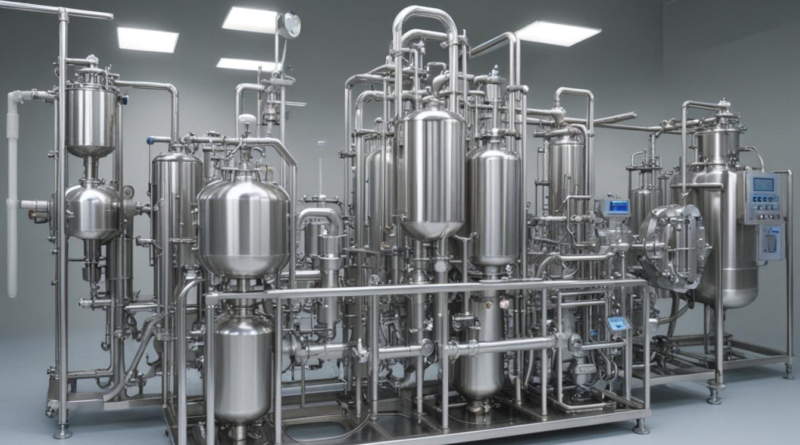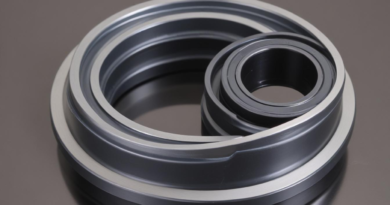how to select a pump for aseptic pharmaceutical processes
Aseptic pharmaceutical processes are essential for producing sterile medicinal products, ensuring they are free from contaminants that could compromise patient safety. These processes encompass several critical stages:
- Raw Material Preparation: All ingredients are sterilized, typically through heat, filtration, or radiation, to eliminate microbial contamination before they enter the production environment.
- Sterilization of Equipment: Equipment such as reactors, filtration units, and transfer lines are sterilized using validated methods like steam sterilization or vaporized hydrogen peroxide to ensure no residual contaminants.
- Controlled Environment: Manufacturing occurs in cleanrooms with stringent environmental controls, including HEPA-filtered air, regulated temperature and humidity, and positive pressure to prevent ingress of contaminants.
- Manufacturing Operations: Processes including mixing, heating, cooling, and filling are conducted in aseptic conditions using sterile equipment and techniques to maintain product sterility.
- Sterile Transfer and Filling: Utilizing aseptic pharma pumps, fluids are transferred between equipment in a manner that preserves sterility, often within isolators or under laminar flow conditions.
- Filtration and Packaging: Final products undergo sterile filtration to ensure microbial limits are met, followed by packaging in sterile containers to prevent recontamination.
Critical Control Points within aseptic processes include:
| Control Point | Objective |
|---|---|
| Sterilization Verification | Confirm the effectiveness of sterilization methods through biological indicators and regular monitoring. |
| Environmental Monitoring | Continuously assess air and surface cleanliness to detect and control potential contamination sources. |
| Personnel Practices | Implement strict gowning procedures and hygiene practices to minimize the risk of contamination from operators. |
Regulatory Compliance is imperative, with guidelines from agencies such as the FDA’s Current Good Manufacturing Practices (cGMP) outlining the requirements for aseptic processing. Compliance ensures that products consistently meet quality standards and are safe for use.
Implementing robust validation protocols is also crucial in aseptic pharmaceutical processes. This includes validating sterilization procedures, environmental controls, and aseptic techniques to demonstrate that the processes reliably produce sterile products.
key selection criteria for pumps
Selecting the appropriate pump for aseptic pharmaceutical processes is critical to ensuring product sterility, process efficiency, and compliance with regulatory standards. Several key criteria must be evaluated to make an informed decision:
- Compatibility with Aseptic Conditions: The pump must maintain sterile conditions throughout the process. This includes being designed to prevent contamination, offering leak-proof seals, and ensuring smooth fluid transfer without introducing particulates.
- Flow Rate and Pressure Requirements: It is essential to choose a pump that can handle the specific flow rates and pressures required for the pharmaceutical process. This ensures consistent product quality and process stability.
- Material Compatibility: All materials in contact with the pharmaceutical product must be compatible to prevent reactions or degradation. Common materials include stainless steel, PVDF, and PTFE, which offer resistance to corrosion and are suitable for sterilization methods.
- Cleaning and Sterilization: Pumps should facilitate easy cleaning and sterilization procedures, such as Clean-in-Place (CIP) and Steam-in-Place (SIP). Features like smooth surfaces, minimal crevices, and detachable components enhance the effectiveness of cleaning processes.
- Reliability and Precision: High reliability ensures minimal downtime, while precision is crucial for accurate dosing and consistent product quality. Pumps with precise control mechanisms and robust performance characteristics are preferred.
- Regulatory Compliance: Pumps must comply with relevant regulatory standards, including FDA’s Current Good Manufacturing Practices (cGMP) and EU guidelines. Compliance ensures that the pump meets safety and quality requirements essential for pharmaceutical manufacturing.
- Ease of Maintenance and Support: Pumps should be designed for easy maintenance, with readily available spare parts and technical support. This minimizes downtime and ensures continuous production.
- Energy Efficiency: Energy-efficient pumps reduce operational costs and support sustainable manufacturing practices. Evaluating the pump’s energy consumption helps in selecting a cost-effective and environmentally friendly option.
Comparison of Key Selection Criteria:
| Criteria | Description | Importance |
|---|---|---|
| Compatibility with Aseptic Conditions | Maintains sterility, prevents contamination | High |
| Flow Rate and Pressure | Matches process requirements for consistency | High |
| Material Compatibility | Resists corrosion, suitable for sterilization | Medium |
| Cleaning and Sterilization | Supports CIP and SIP procedures effectively | High |
| Reliability and Precision | Ensures minimal downtime and accurate dosing | High |
| Regulatory Compliance | Meets cGMP and EU standards | High |
| Ease of Maintenance and Support | Facilitates quick repairs and part replacements | Medium |
| Energy Efficiency | Reduces operational costs and environmental impact | Low to Medium |
Additional Considerations:
- Integration with Existing Systems: Ensure that the selected pump can be seamlessly integrated with current manufacturing equipment and control systems.
- Scalability: Consider future production needs and select pumps that can handle increased capacity without significant modifications.
- Total Cost of Ownership: Evaluate not only the initial purchase price but also long-term costs related to maintenance, energy consumption, and parts replacement.
By meticulously assessing these criteria, manufacturers can select pumps that not only meet the technical demands of aseptic pharmaceutical processes but also support operational efficiency and regulatory compliance.
types of pumps used in aseptic environments
Aseptic environments demand pumps that can reliably maintain sterility while handling sensitive pharmaceutical fluids. Various types of pumps are employed to meet these stringent requirements, each offering unique advantages tailored to specific process needs.
- Peristaltic Pumps: These pumps operate by compressing a flexible tube or hose, creating a vacuum that moves the liquid. Their design ensures that the fluid only contacts the tubing, minimizing contamination risks. Peristaltic pumps are ideal for applications requiring gentle handling of shear-sensitive products, such as live biological cultures.
- Diaphragm Pumps: Utilizing a reciprocating diaphragm driven by pistons or other mechanisms, these pumps provide precise control over flow rates and pressures. Their ability to handle viscous and abrasive fluids makes them suitable for transferring a wide range of pharmaceutical products while maintaining aseptic conditions.
- Centrifugal Pumps: These pumps use rotational energy to transfer fluids through centrifugal force. While offering high flow rates and efficiency, centrifugal pumps are best suited for applications where gentle handling is not a primary concern. Proper design modifications, such as sealed shafts and hygienic wetted parts, are essential to maintain asepsis.
- Gear Pumps: Operating through the meshing of gears, these pumps deliver a consistent and precise flow. They are particularly effective for dosing applications and handling high-viscosity fluids. The enclosed design of gear pumps helps prevent contamination, making them a reliable choice for aseptic pharma pumps.
- Magnetic Drive Pumps: Featuring a magnetically coupled impeller, these pumps eliminate the need for a traditional mechanical seal. This reduces the risk of leakage and contamination, ensuring superior aseptic integrity. Magnetic drive pumps are ideal for handling hazardous or sensitive pharmaceutical substances.
- Positive Displacement Pumps: Including various subtypes such as piston and lobe pumps, positive displacement pumps deliver a fixed volume of fluid with each cycle. Their ability to maintain a consistent flow rate under varying pressures makes them suitable for precise dosing and metering applications in aseptic processes.
Comparison of Common Pump Types in Aseptic Environments:
| Pump Type | Advantages | Considerations |
|---|---|---|
| Peristaltic Pumps |
|
|
| Diaphragm Pumps |
|
|
| Centrifugal Pumps |
|
|
| Gear Pumps |
|
|
| Magnetic Drive Pumps |
|
|
Selecting the appropriate pump type is crucial for maintaining aseptic conditions and ensuring the integrity of pharmaceutical processes. Factors such as fluid properties, required flow rates, precision, and maintenance capabilities should guide the selection to achieve optimal performance and compliance with regulatory standards.
materials and compatibility considerations
 Material selection plays a pivotal role in ensuring the integrity and sterility of pharmaceutical products during aseptic processes. The materials used in pump construction must be carefully chosen to withstand rigorous sterilization methods, resist corrosion, and maintain compatibility with a wide range of pharmaceutical fluids. This ensures that the pump does not introduce contaminants or degrade the product quality.
Material selection plays a pivotal role in ensuring the integrity and sterility of pharmaceutical products during aseptic processes. The materials used in pump construction must be carefully chosen to withstand rigorous sterilization methods, resist corrosion, and maintain compatibility with a wide range of pharmaceutical fluids. This ensures that the pump does not introduce contaminants or degrade the product quality.
Common Materials Used in Aseptic Pharma Pumps include:
- Stainless Steel (316L): Renowned for its excellent corrosion resistance and durability, 316L stainless steel is a staple in pharmaceutical pump manufacturing. Its smooth surface finish minimizes microbial adhesion, facilitating easier cleaning and sterilization.
- Polytetrafluoroethylene (PTFE): PTFE offers exceptional chemical resistance and is ideal for handling aggressive solvents and reactive substances. Its non-stick properties reduce the risk of product buildup, enhancing pump hygiene.
- Polyvinylidene Fluoride (PVDF): PVDF combines chemical resistance with thermal stability, making it suitable for a variety of pharmaceutical applications. It also possesses good mechanical properties, ensuring reliable pump performance.
- Ethylene Propylene Diene Monomer (EPDM): Used primarily for seals and gaskets, EPDM provides excellent resistance to heat and steam sterilization, maintaining its integrity under harsh conditions.
- Silicone: Silicone elastomers are favored for their flexibility and resistance to a wide temperature range, making them suitable for dynamic components within pumps.
Key Considerations for Material Compatibility:
- Chemical Compatibility: Materials must be inert and non-reactive with the pharmaceutical products they contact to prevent contamination and ensure product stability.
- Sterilization Methods: The chosen materials should withstand common sterilization techniques such as steam-in-place (SIP), clean-in-place (CIP), and gamma irradiation without degrading or leaching harmful substances.
- Mechanical Properties: Adequate strength, flexibility, and wear resistance are essential to maintain pump functionality and longevity under operational stresses.
- Cleanability: Smooth surfaces and minimal crevices are crucial for effective cleaning, preventing microbial harboring and ensuring aseptic conditions.
- Regulatory Compliance: Materials must comply with relevant regulatory standards, including FDA’s Current Good Manufacturing Practices (cGMP) and European Medicines Agency (EMA) guidelines, ensuring safety and efficacy.
Material Compatibility Matrix:
| Material | Chemical Resistance | Sterilization Compatibility | Applications | Regulatory Compliance |
|---|---|---|---|---|
| 316L Stainless Steel | High | Steam, Autoclave, Radiation | Pump Housing, Valves | cGMP, USP Standards |
| PTFE | Exceptional | Steam, Radiation | Seals, Liners | cGMP |
| PVDF | High | Steam, UV | Pump Components | cGMP, EMA |
| EPDM | Moderate | Steam | Gaskets, Seals | cGMP |
| Silicone | Moderate | Steam, Radiation | Elastomers, Seals | cGMP |
Additional Compatibility Considerations:
- Thermal Stability: Ensure materials can endure the temperature ranges experienced during processing and sterilization without deformation or loss of functionality.
- Biocompatibility: Materials must be biocompatible to prevent adverse reactions if there is any possibility of contact with the pharmaceutical product intended for human use.
- Surface Finish: A high-quality surface finish reduces areas where contaminants can accumulate, enhancing the pump’s aseptic integrity and ease of cleaning.
- Wear and Corrosion Resistance: Materials should exhibit minimal wear and resist corrosion to extend the pump’s operational lifespan and maintain consistent performance.
By carefully evaluating and selecting materials that meet these compatibility considerations, manufacturers can ensure that aseptic pharma pumps perform reliably, maintain product sterility, and comply with stringent regulatory standards. This meticulous approach to material selection is fundamental in safeguarding product quality and patient safety in pharmaceutical manufacturing.
installation, validation, and maintenance
Proper installation of aseptic pharma pumps is critical to maintaining the integrity of pharmaceutical processes. It begins with meticulous planning to ensure that the pump is compatible with existing systems and that the installation site meets all environmental requirements. During installation, it is essential to verify that all connections are secure and leak-proof, preventing any risk of contamination. Aligning the pump accurately with other equipment minimizes mechanical stress and ensures smooth operation. Additionally, environmental controls such as temperature, humidity, and air quality must be maintained to preserve aseptic conditions during and after installation.
Validation of aseptic pharma pumps ensures that they perform consistently and reliably within the specified parameters. The validation process typically involves three key phases:
- Installation Qualification (IQ): Confirms that the pump is installed correctly according to manufacturer specifications and that all necessary components are present and accounted for.
- Operational Qualification (OQ): Verifies that the pump operates as intended under all defined conditions, including flow rates, pressures, and temperature ranges.
- Performance Qualification (PQ): Demonstrates that the pump consistently performs according to the required specifications during actual pharmaceutical processes.
Comprehensive documentation is a vital aspect of validation, ensuring compliance with regulatory standards such as the FDA’s Current Good Manufacturing Practices (cGMP). Proper validation not only guarantees product quality and patient safety but also facilitates regulatory inspections and audits.
Maintenance of aseptic pharma pumps involves regular preventive measures to ensure ongoing reliability and performance. Establishing a detailed maintenance schedule helps in identifying and addressing potential issues before they escalate into significant problems. Key maintenance practices include:
- Routine Inspections: Regularly check for signs of wear, leaks, and proper functioning of all pump components.
- Cleaning and Sterilization: Implement stringent cleaning protocols, such as Clean-in-Place (CIP) and Steam-in-Place (SIP), to maintain aseptic conditions and prevent microbial contamination.
- Component Replacement: Replace worn or damaged parts promptly to avoid downtime and ensure the pump operates within desired parameters.
- Calibration: Periodically calibrate the pump to maintain accurate flow rates and pressures, ensuring consistent product quality.
Effective maintenance strategies not only extend the lifespan of aseptic pharma pumps but also enhance operational efficiency and reduce the risk of unexpected failures.
Training and Support are integral to the successful installation, validation, and maintenance of pumps in aseptic environments. Personnel must be adequately trained on the specific requirements and procedures associated with aseptic pharma pumps. Training should cover:
- Installation Procedures: Detailed instructions on correctly installing pumps to maintain aseptic conditions.
- Operational Guidelines: Comprehensive understanding of pump operation, including start-up, shut-down, and emergency procedures.
- Maintenance Protocols: Knowledge of routine maintenance tasks, troubleshooting techniques, and proper cleaning methods.
Additionally, having access to technical support from pump manufacturers or specialized service providers ensures that any issues can be resolved promptly and effectively. Regular training updates and refresher courses help maintain a high level of competency among staff, fostering a culture of quality and compliance.
Record-Keeping and Documentation are fundamental to maintaining regulatory compliance and ensuring traceability of all activities related to pump installation, validation, and maintenance. Detailed records should include:
- Installation Logs: Documentation of the installation process, including verification of component integrity and alignment.
- Validation Reports: Comprehensive records of IQ, OQ, and PQ activities, along with results and any deviations encountered.
- Maintenance Records: Logs of all maintenance activities, including inspections, cleaning, part replacements, and calibrations.
- Training Certificates: Proof of personnel training and competency in operating and maintaining aseptic pharma pumps.
Maintaining thorough and accurate documentation not only supports ongoing compliance with regulatory standards but also facilitates continuous improvement by providing valuable insights into pump performance and maintenance effectiveness.
By adhering to best practices in installation, validation, and maintenance, pharmaceutical manufacturers can ensure that their aseptic pharma pumps operate reliably, maintain product sterility, and comply with stringent regulatory requirements. This comprehensive approach safeguards product quality, enhances operational efficiency, and ultimately supports the delivery of safe and effective pharmaceutical products to patients.




